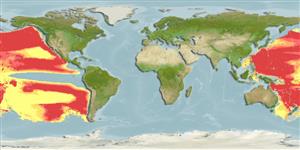Classificação / Names
Nomes comuns | Sinônimos | Catalog of Fishes(Gênero, Espécies) | ITIS | CoL | WoRMS | Cloffa
>
Lophiiformes (Anglerfishes) >
Oneirodidae (Dreamers)
Etymology: Tyrannophryne: Greek, 'tyrranos' or Latin, 'tyrannus' = tyrant + Greek, 'phryne' = toad (to mean "tyrannical toad" in reference to its menacing look; common name derived from type species T. pugnax) (Ref. 86949 ).
More on authors: Regan & Trewavas.
Environment: milieu / climate zone / depth range / distribution range
Ecologia
marinhas batipelágico; intervalo de profundidade 400 - 2100 m (Ref. 86949). Deep-water
Pacific Ocean: Eastern Central Pacific (Ref. 40966); western and central Pacific, including South Pacific (Ref. 86949).
Tamanho / Peso / Idade
Maturity: Lm ? range ? - ? cm
Max length : 4.7 cm SL (female)
Descrição suscinta
Chaves de identificação | Morfologia | Morfometria
Raios dorsais (total) : 5; Raios anais : 5. Metamorphosed females distinguished by having an extremely large oblique mouth; elements of upper and lower jaws extending posteriorly far beyond the base of the pectoral fin and opercular opening; vomerine teeth present or absent; well developed sphenotic spines; well-developed symphisial spine on lower jaw; elongate and tapering angular, forming long narrow spine; hypomandibula with two heads; small quadrate spine, however, longer than articular spine; deeply notched posterior margin of opercle; short and broad subopercle, dorsal end rounded, ventral end nearly circular; toothless pharyngobranchial II; caudal fin lacking internal pigmentation; extremely short illicium, almost totally enveloped by tissue of esca in smaller specimens; well developed first ray of dorsal fin; dorsal fin rays 5; anal fin rays 5; short and broad pectoral fin lobe, shorter than longest rays of pectoral fin; pectoral fin rays 18-20; skin naked, lacking dermal spinules; darkly pigmented skin of caudal peduncle extends well past base of caudal fin (Ref. 86949).
Ciclo de vida ou comportamento de acasalamento
Maturidade | Reprodução | Desova | Ovos | Fecundidade | Larvas
Nielsen, J.G., 1974. Fish types in the Zoological Museum of Copenhagen. Zoological Museum of Copenhagen, Denmark. 115 p. (Ref. 38022)
Status na Lista Vermelha da UICN (Ref. 130435: Version 2024-2)
Ameaça para os humanos
Harmless
Uso pelos humanos
Ferramentas
Relatórios especiais
Baixar XML
Fontes da internet
Estimates based on models
Preferred temperature (Ref.
123201): 3.4 - 5.3, mean 4.5 °C (based on 371 cells).
Índice de diversidade filogenética (Ref.
82804): PD
50 = 1.0000 [Uniqueness, from 0.5 = low to 2.0 = high].
Bayesian length-weight: a=0.01000 (0.00244 - 0.04107), b=3.04 (2.81 - 3.27), in cm total length, based on all LWR estimates for this body shape (Ref.
93245).
Nível Trófico (Ref.
69278): 3.4 ±0.5 se; based on size and trophs of closest relatives
Resiliência (Ref.
120179): Elevada, tempo mínimo de duplicação da população menor que 15 meses (Preliminary K or Fecundity.).
Fishing Vulnerability (Ref.
59153): Low vulnerability (10 of 100).
